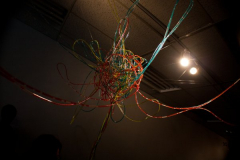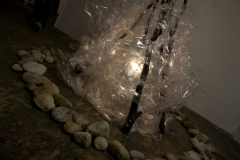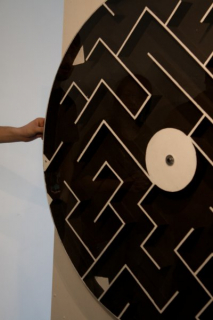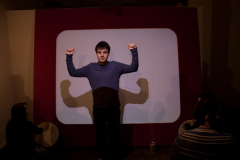Concordia
Joe Wang, Katarina Veljovic, Michael Jeong
Tubes, motors, wood, metal, plexiglass, water, food colouring, oil, etc.
Description:
Concordia is the physical manifestation of an idea, the creative process, the collaborative process, and a mirror for the viewer’s self reflection of the piece itself.
Each tube represents the progression of an idea, and the infectious nature of that idea. At the same time however, there are other tubes intertwined together, thus making one tube only a single part in a collective whole. This is a reflection of collaborative efforts, and the experience of our group since we have become a group. Each of our ideas have effected the other, reinforcing some concepts, or spawning others in completely different tangents. The key is however, collaborative harmony. Just like it is represented in the tanglement of the tubes, one person is not any more important than the other, they all work in unity to contribute to a single goal.
Concordia has three sides, of which all have their own sensor and assigned tube. As people approach a side, the sensor is set off and movement in the aforementioned tube occurs. The movement in the tube acts as a self-aware mirror into the viewer’s pensive thoughts. To elaborate, as they think about the piece and its meaning, the piece is actually physically showing the viewer’s thought process back at them. As more people approach Concordia, and the other sides are set off, they become aware that their presence, and consequently their thoughts, are contributing to one single structure. The viewers are essentially inadvertently collaborating with each other.
________________________________________________________________________________________
Untitled
Delaney Swanson, Galen MacLusky, Emily Bierman
Found plastic, wood, rocks
Description:
This piece calls the viewer to question many things about our relationship with plastic. When you look at the plastic bonfire with naked eyes you can appreciate its aesthetics but may be taken by the shear amount of plastic, particularly when considering that it was all collected as garbage. When the visitor then puts the provided glasses on to view the piece the sculpture changes; some hopeful flickers of colour dance along the plastic, changing the scene in an important way. At first the plastic is a problem, a reminder of the near-impossible environmental challenges it presents to our world. But with the glasses, the perspective changes every so slightly, to one of opportunity and optimism. Change must happen, but it can be done, and it can be good.
Our choice of a bonfire as form for our piece was very strategic. First, fire and plastic are incredibly similar in that when controlled, they are both paradigm-shifting tools for mankind. But when that control is lost, they present themselves as undeniable threats. This form might also remind the viewer of burning plastic, which most know to avoid breathing in its dangerous fumes. Ironically though, we see no threat in spending our lives surrounded by it; many have even called this period of human civilization the “Plastic Era”. One may argue that we, as a culture, worship it. This is another parallel to fire and its central role in the practice of rituals throughout history. It is as if our culture is perpetually crowded around the flames of our plastic salvation. And in our blissful ignorance, we’ve let our dependence on it get out of control—but as the flames of our piece lick the ceiling, just on the cusp of spreading, we still have the chance to control it if we act quickly.
________________________________________________________________________________________
Many Hands, Many Minds
Chimere Ukasoanya, Keith deVries, Amanda Sutanto, Kathleen Curwin
steel and plastic wood, Masonite, Paint.
Description:
In the process of coming up with thoughts and ideas for this project, we went through many obstacles and dead ends. It wasn’t that each idea an individual in our team came up with was terrible. Each idea was great, some were even outstanding, and each of these ideas had potential to be the start of an incredible piece of art. But the more work we put into these ideas, working past obstacles and figuring out limitations etc, the harder it became to settle on an idea.
But each idea evolved into new possibilities because we were able to work as a team. This lead us to creating this maze that can only be solved with patience and with the coordination of two or more people. There are multiple exits to the maze, symbolizing the wealth of solutions available through collaboration.
________________________________________________________________________________________
Betch-can’t-Etch-a-Sketch
Christina Kowalenko, Dhananja Jayalath, Melinda Poss, Toby Balogurd
mdf, ply wood, paint, rubber mats, fabric, projector, chalkboard eraser, arduino, switches, rotary coaters
Description:
Artistic collaboration is a prevalent theme in contemporary art and hence has been a prevalent theme of this course. Some argue that collaboration can increase the potential of a work of art, while others feel that it impairs true ability. Betcha-can’t-Etch-a-Sketch is an investigation into the positive outcomes of collaboration in art. The viewer is confronted with a large scale Etch-a-Sketch, a toy whose use is intuitive to many. However, upon interaction one realizes that the distance between the knobs allows for only one to be used at a time. Individually, a work of art can be made, but the end result will always be limited as curves cannot be formed unless both dials are turned at the same time. Collaboration allows more artistic possibilities yet highlights the need for communication, co-operation and team work. This work immerses each user in the exact process that our group had to struggle with to produce the piece. It reveals one’s ability to collaborate and create in a positive environment.
Click on images to enlarge and click again to close.
Return to the projects page.


















